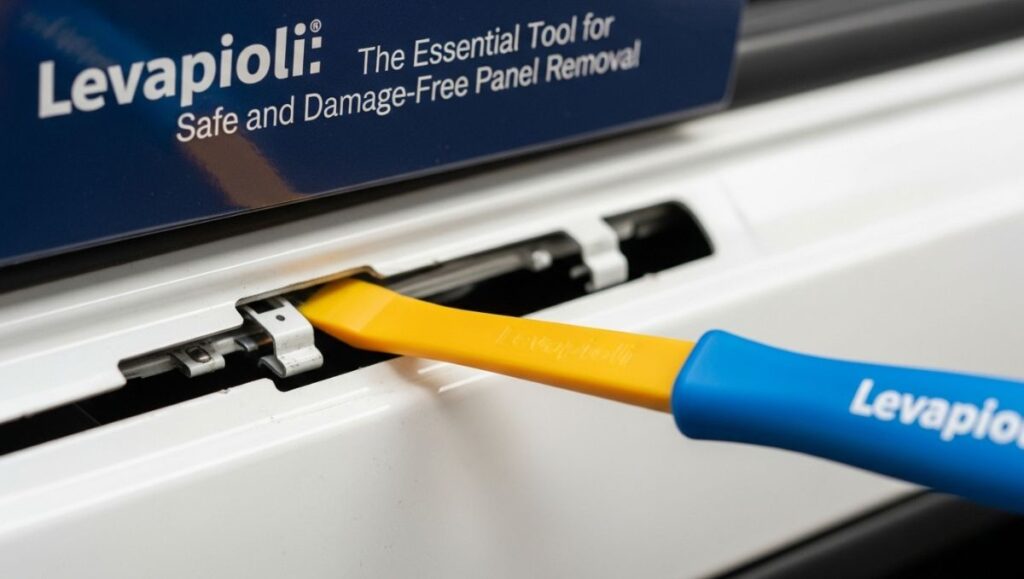What is Levapioli?
The term levapioli might sound unfamiliar, yet for those in certain trades it is becoming a key piece of equipment. At its core, levapioli refers to a specialized tool designed for the safe removal of plastic fasteners, clips or pins—elements often used in automotive interiors, trim work or panel attachments. By using a levapioli instead of improvised tools like screwdrivers or standard pry bars, the risk of damage is greatly reduced. The tool’s design emphasises leverage, access into tight spaces and protective contact with the material being worked on. It’s no exaggeration to say that for panel-removal work, the right levapioli can save time, parts and frustration.
Origins of the Levapioli Tool
While detailed historical records of the levapioli are sparse, the tool clearly evolved in response to an industry need: removing molded push-in clips, tree-style fasteners and expansion rivets without breaking the clip, cracking the surrounding trim or scratching the finish. In automotive repair particularly, door panels, dashboards, kick-plates and bumper trims often are held by such fasteners. Traditional screwdrivers and generic tools were widely used—but they came with risk. The levapioli emerged as a purpose-built solution—typically featuring a forked or notched tip, sometimes made of plastic or nylon to avoid marring surfaces, sometimes steel coated for strength but still designed for non-destructive removal. So it’s less a century-old artifact and more a pragmatic adaptation to modern manufacturing and repair challenges.
Design and Features of a Quality Levapioli
What sets a good levapioli apart from a generic pry-tool? Several features matter:
-
Tip geometry: Many levapioli have a forked tip, or notched angle, crafted to engage under the head of a clip rather than force the head sideways.
-
Material choice: Tools made from nylon or polymer composites protect adjacent surfaces; some are steel cores with protective sleeve.
-
Leverage and ergonomics: A long handle or carefully bent shaft ensures the necessary mechanical advantage while keeping the hand clear of pinch-points.
-
Shape suited for access: The tool may bend or curve to reach behind panels or into recesses, to pop fasteners cleanly.
Thus, using a proper levapioli reduces the chance of damaging trim, avoids broken fasteners that must be replaced and makes the job faster and cleaner.
Why Use a Levapioli? The Benefits
Investing in the correct tool pays off. Here are key benefits of choosing a levapioli rather than improvising:
-
Preserves trim integrity: The tool is designed to minimise scratches, gouges or broken panel edges.
-
Reduces clip-damage: Many clips are fragile; incorrect removal may deform or shear off the fastener head, requiring replacement.
-
Saves time and frustration: A clean removal means less time, less struggle and fewer follow-up fixes.
-
Professional finish: Using a purpose-tool gives better results and demonstrates attention to detail—important for commercial repair or personal pride.
In short, the levapioli isn’t just a gimmick—it’s a practical upgrade for quality work on panels and trims.
When and Where to Use a Levapioli
The levapioli finds its home in various contexts where plastic rivets, push-pins or tree clips are common. Some typical uses:
-
In automotive interior door panels, kick-plates, headliners or dashboard trim.
-
In bumper skirts, engine-bay plastic panels, wheel-well liners.
-
In appliance or equipment panels where similar plastic fasteners are used.
-
In DIY or restoration work where maintaining original clips and finishes is important.
If you are removing any panel held by such fasteners, then a levapioli is likely the right tool for the job.
How to Use a Levapioli Correctly
Using the tool effectively involves more than simply prying. Follow these best practices:
-
Identify the fastener type: Pin style, expansion clip, tree-type or push ridge.
-
Engage under the head: Slide the forked tip beneath the clip head rather than forcing the head sideways or lifting from the plastic stem.
-
Apply controlled leverage: Use the long handle to lift gently and consistently; avoid sudden jerks.
-
Support adjacent trim: Keep pressure away from fragile edges; if possible support the panel as you remove the fastener.
-
Remove the clip intact: When properly done, you should retrieve the clip in one piece and avoid damage to the panel or fastener.
-
Replace if necessary: If the clip is damaged, replace it rather than re-using a broken one—it may lead to looseness or rattle later.
When used properly, the levapioli makes the job cleaner and safer.
Selecting and Buying a Levapioli
If you’re ready to add a levapioli to your tool set, here are things to check:
-
Material: Does the tool use nylon or polymer safe for trim surfaces? Is the tip reinforced?
-
Size and shape: Does the tool fit the fastener types you commonly encounter? Some sets include multiple sizes.
-
Brand and build quality: Higher-quality versions tend to last longer and protect surfaces better.
-
Inclination/angle: A good tool accounts for access geometry—tight spaces, curved panels, door inner skins.
-
Cost vs value: While a levapioli isn’t expensive in the grand scheme, the savings it gives in avoiding damage can be significant.
In short, choose a version suited to your work, materials and budget.
Common Mistakes and How to Avoid Them
Even with the right tool, errors can occur. Here are frequent mistakes and how to avoid them:
-
Using a screwdriver instead of a levapioli: leads to dents or broken clips.
-
Applying force at the wrong angle: May shear the clip or tear the trim edge.
-
Ignoring support of panel: Pulling on the fastener without supporting adjacent surface can crack or warp the panel.
-
Re-using damaged clips: Reusing broken fasteners invites looseness, vibration or panel sag.
By recognising these pitfalls upfront, you’ll get better results.
Beyond Automotive
While the tool is most common in auto and trim work, the principles behind the levapioli extend further:
-
In furniture assembly/disassembly: removing plastic rivets or anchors without gouging wood or MDF.
-
In appliance servicing: access panels often use plastic fasteners.
-
In electronics housing: when removing plastic shells with push-pins or molded clips.
-
In restoration of classic cars: preserving original fasteners and finishes is especially important.
Thus, the levapioli concept—safe, efficient, purpose-built removal—is applicable in any scenario where plastic clips, trim panels or molded fasteners are present.
Maintaining Your Levapioli Tool
Like any tool, a levapioli needs basic care:
-
Clean after use: Dirty material may scratch surfaces if left on the tool.
-
Inspect the tip: If the forked tip is worn or chipped, the tool may damage panels rather than protect them.
-
Store properly: Keep the tool away from solvents or chemicals that degrade polymers.
-
Use for its purpose: Don’t lever large metal parts with the tool—this risks bending it and making it ineffective for its intended job.
With proper care, your levapioli will last and continue to perform.
Is a Levapioli Worth It? My Take
From my experience working on trim and panel removal, investing in a dedicated levapioli tool paid off quickly. Before I had one, I’d often risk scratching door panels or breaking retention clips during removal. Once I switched to the right tool, I saw fewer replacements, fewer touches-up and faster jobs. The cost of a ruined panel or lost clip almost always outweighs the cost of the tool. If you do panel trim, bumper liners or interior work—even occasionally—then a levapioli isn’t just nice-to-have—it’s smart. It delivers better results and reduces stress. In short: yes, for many of us it’s worth it.
Summary
To sum up, the levapioli is a specialised, purpose-built tool designed for safe, efficient removal of plastic fasteners, clips and panel-retention systems. Its design focuses on protecting surfaces, preserving clips, saving time—and reducing frustration. Whether you’re in automotive trim work, appliance servicing, furniture restoration or DIY interior projects, the levapioli offers real value. By understanding how and when to use it—and selecting a quality version—you’ll get better results with less mess. If you haven’t yet adopted one into your toolkit, it may be the upgrade your jobs deserve.
FAQs
What kind of fasteners is the levapioli designed for?
It’s designed for plastic push-pins, “Christmas tree” clips, expansion rivets and other molded panel fasteners, commonly found in vehicles, appliances and trim panels.
Can I use a screwdriver instead of a levapioli?
Technically yes, but using a screwdriver often risks scratching or damaging adjacent trim, breaking the clip or requiring extra cleanup—so a levapioli is the safer and more professional tool.
Is the levapioli only for automotive use?
No. While very common in automotive work, the tool’s principles apply to any scenario with plastic fasteners and panels: furniture, appliances, electronics, DIY projects.
What material should I look for in a good levapioli?
Nylon or polymer composite tips are ideal for protecting surfaces; some tools may have a steel core but must be coated or designed not to scratch the workpiece.
How do I know when to replace a levapioli?
If the tip is worn, chipped, bent, or no longer engages clips cleanly without damaging the panel, it’s time to replace. A degraded tool defeats its purpose.
Does using a levapioli guarantee no damage?
No guarantee, but by using the proper tool in a correct way you greatly reduce the risk of damage. Good technique, paired with a good tool, is what delivers the result.






